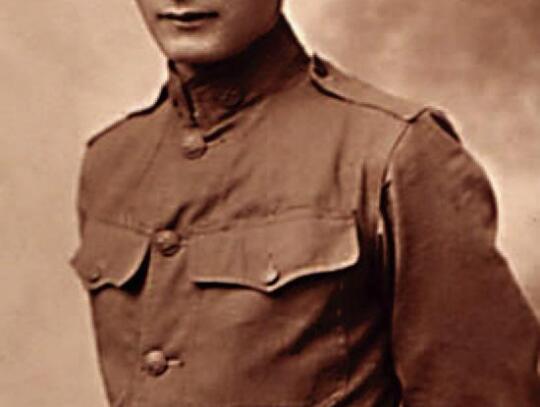World War I
Edward Wanke was born at Foster in 1895, to Edward and Monika Wanke. In the 1910 census, I found Edward living only with his mother and siblings Otto and Minnie, but his mother was not listed as a widow, and I knew his father didn’t die until 1916, so I wondered where he was.
I then found his father in the 1910 census living in the Nebraska State Asylum/Hospital; he died at the young age of 46 or 47. According to Ed Jr.’s daughter, Audrey Dummer, her grandfather contracted tuberculosis, which was why he was sent away. Ed Jr.’s family only had a horse and buggy for travel, and it was too far away, so they couldn’t even go visit him. Edward Sr. was buried in the Ingleside Cemetery near Hastings, which was used as a burial place for patients at the Hastings Regional Center between 1889 and 1959. I found it sad that most of those buried there only have a marker with a number, if that. Edward Sr.’s number is 1585. Edward Jr. enlisted in the Army May 28, 1918. He was a private in Battery E, the 338th Field Artillery. Unfortunately, I couldn't find much information about this specific unit. I did find him on a soldier transport list leaving Aug. 18, 1918, from New York on the Tras Os Montes.
Daughter Audrey said, “When service men left for the war, my mom said we went to the train station to see them off and also when they returned home. North Platte had a big welcoming of troops going through their town with a prepared meal. The country was behind their servicemen.”
According to his daughter, Ed contracted what became known as the Spanish flu while on the ship, and was placed in the bilge of the ship with others who weren’t expected to live. One of the workers on the ship was later surprised to see him sitting on deck. He had survived!
The information on the ship transport paper stated that his unit was part of the 88th Division, and information I found on the 88th division stated “The division sailed in stages to England in August and September 1918, and moved to France. Elements of the division participated in training near the front lines with the French Army, and occupied quiet sectors of the front in Alsace beginning in early October 1918. The Armistice ended the war a month later.”
Audrey confirmed that, saying that
the soldiers were put on cattle cars to travel to their destination, and it took so long for their train to get there that the war had ended before they arrived.
Edward was discharged from the Army Jan. 17, 1919. Except for when Edward was in the service, he, Otto and Minnie stayed on the farm with their mother, and the boys didn’t marry until after her death.
Edward was a farmer and a carpenter all his life, and he lived in the Foster area after the war. A little under a year after his mother died, in 1937 when he was about 42 years old, he married Marguerite Sherman.
According to their family history in the Centennial book, they farmed north of Pierce, but the censuses of 1940 and 1950 shows them living in Foster Precinct, which was actually northwest of Pierce.
Edward and Marguerite had one daughter, Audrey Dummer, who now lives in Colorado and who provided his picture for this article.
Audrey said about her father, “I remember how the young fathers nearby always asked Ed for information about farming. Ed quit school in the seventh grade to farm, but I was amazed how he did some electrical wiring. Where did he get this information? There was no Google back then.”
She also noted that he belonged to the Pierce VFW because his wife’s relatives, neighbors and farm business were in Pierce. 'He also knew most of the farmers along the road leading to Osmond. I also remember going to Foster to sell their eggs and cream and the bank there.'
Edward died June 12, 1969, at the age of 74. He is buried in St. Mary’s Catholic Cemetery, as are his mother, wife, brother and sister.








